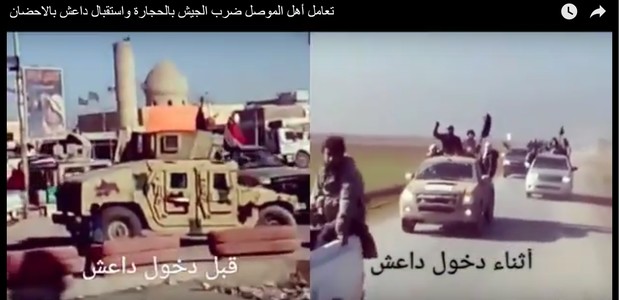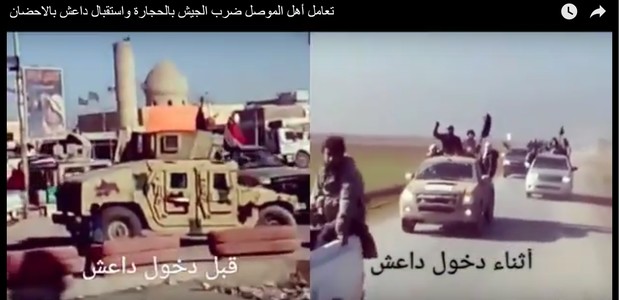Special Correspondent | Baghdad | (Niqash.org) | – –
Controversial videos are common on Iraqi social media. Viewed by millions, they increase social division and violence. NIQASH tries to separate two particularly disturbing examples into fact or fiction.
The divisions between the different components of Iraqi society, whether those are ethnic or religious, has only widened since the security crisis began. The extremist Islamic State group has caused neighbours to become suspicion of neighbours and split tribal groups and families along political lines. This divide is also reflected on social media platforms like Facebook and Twitter where Iraqis disseminate video clips and posts that back up their own prejudices. Sometimes the Iraqi media will even pick up on the most contentious of these videos and broadcast them to a wider audience.
As the fighting around the city of Mosul, taken over by the Islamic State, or IS, group in mid-2014, has intensified over the past few months, so has partisan posting on Iraq’s social media, locals say. Judging by the number of shares, re-posts, re-tweets and views, which often rise into the millions, this kind of material can have a lasting impact, not just on the current fighting but on Iraqi society long term.
In a recent video, Iraqi soldiers allegedly shoot a teenager, then crush his body under their tank.
This is why it remains vital that that video clips and pictures be properly investigated before they are shared – and particularly, before they are broadcast. And that is even if, as the investigations below reveal, the answers are not always easy to acknowledge.
The Teenager Killed By A Tank – But Whose Tank Was It?
One of the most controversial video clips circulating on Iraqi social media recently involved Iraqis in military clothing shooting a teenage boy they accused of being a member of the IS group, then running his corpse over with a tank. The video clip was widely shared and the perpetrators were accused of being members of a number of different fighting groups in the country. The clip was also re-published by international media.
The video, which looked as though it had been shot on a mobile phone camera by one of the participants in the violent act, first emerged in early November, around a month after the campaign to re-take the northern Iraqi city of Mosul from the IS group began. Some sources suggest the video was first broadcast by the IS group itself while an Iraqi Kurdish journalist was one of the first to share the clip on the K24 news channel.
The Sunni-majority Iraqi National Forces Alliance was quick to denounce the incident in the video. “This is a war crime,” their official statement said, “and those who committed it should not escape punishment. This new crime is just the latest in a series of those committed against innocent citizens in liberated areas, the same as those that happened in Fallujah and elsewhere,” they added; the political group is referring to accusations against Iraqi forces, both official and unofficial, that they take unlawful revenge on ordinary Sunni citizens in areas previously controlled by the IS group, which bases its extreme ideology on its own version of Sunni Islam.
The head of the Iraqi army in Ninawa, fighting the IS group in Mosul, denied that his forces could be involved. He said it was more likely that members of the IS group had dressed up as the Iraqi army and had made this video to spread disinformation about his troops.
After all, it is well known that the IS group had been spreading rumours in and around Mosul about what would happen if the Iraqi military pushed them out, warning of massacres and other misdeeds in an attempt to encourage locals to fight on their side. They had already used footage from unrelated incidents to cause fear among the civilian population in the city.
A still from the video shows the teenager being dragged toward the tank.
The senior military commander then called upon local media and civil society and human rights organisations to verify the events in the video. A team of NIQASH journalists have tried to follow up on this suggestion.
This is what they found: The video is filmed in a desert area and there are no significant landmarks in the video that would allow further research on the location. The tank itself isn’t flying any flags that could show who it belongs to. But the make and origins of the tank would seem significant as certain fighting forces inside Iraq only have access to certain vehicles.
A closer look for the tank used in the video seems to show that it is a T-72, a tank of Soviet design that the Iraqi military has used for decades. Some of them were manufactured in Iraq too. Iraq’s Shiite Muslim volunteer militias also have some of these tanks.
However, the IS group do not appear to have any of these tanks in Iraq* – the extremists have captured equipment from both the Iraqi and Syrian armies but, in parades of their hardware in Iraq, they have not shown off a T-72 tank. The IS group’s tanks include US-made Abrams, captured from the Iraqi military in the early days of the security crisis, and other Soviet-era models, possibly originating with the Syrian army.
Also, worthy of closer examination is the conversation between the soldiers and the child they kill. Locals say the dialect is distinctively southern Iraqi. The way that one of the men in the video says the name Haider and then how another of the perpetrators asks the child “where have you been hiding?” are notable. He uses the word “labed” (hiding), a term used mainly in southern Iraq.
Given that southern Iraq is mostly populated by Shiite Muslim Iraqis, and that the IS group appealed mainly to Sunni Muslims, in central and northern Iraq, that is a strike against “the- IS-did-it” theory.
One of the other men in the video tells his colleagues that they shouldn’t be doing this. He suggests that the group take the boy to “the regiment’s headquarters”. The other man refuses. Of course, this could all be an act. But if real, then the unwilling man’s suggestion about headquarters does seem to rule out Shiite Muslim volunteer militias in this particular incident – they do not have regiments.
Although it looks increasingly unlikely that it was an IS ruse, it is still not clear who committed this war crime. So far, the Iraqi army has only made one statement about this widely circulated video, denying it was their soldiers. But if justice is to be done, then officials should investigate this video further.
Mosul Locals Protest Arrival of Iraqi Forces – Or Do They?
Back in the middle of 2014, when the extremist group known as the Islamic State took control of the northern Iraqi city of Mosul, a controversial video began to circulate in Iraq. It appeared to show the residents of Mosul throwing rocks at an official Iraqi government convoy, including military vehicles.
The video, almost three minutes long, was touted as being a sign of how the locals in Mosul, a mostly Sunni Muslim-populated city, were opposed to the mostly Shiite-Muslim-led government. More worryingly, some antagonists said it was a sign of how Mosul locals were ready and willing to cooperate with the extremist Islamic State, or IS, group, in driving the government out of their city.
The video, the current incarnation of which was loaded onto YouTube in October 2016, was widely spread on social media as well as broadcast by several satellite channels in Iraq. It has been seen almost 1.5 million times in total, probably more.
But even a small amount of research would have shown that the video had been published many times before and that its earliest date for uploading was in June 2013 – that is, a full year before the IS group came to Mosul.
Additionally, further geolocation research – that is, investigating where the clip was filmed – indicates decisively that the event didn’t happen anywhere near Mosul. The green and black flags hung around the neighbourhood in which the event took place are the same kind Iraq’s Shiite Muslim civilians often hang from powerlines and from their homes and rooves, to indicate their sectarian affiliation. Given that Mosul is mostly populated by Sunni Muslims, that is the first sign that the event didn’t take place in Mosul.
Another sign is the dialect of the young men throwing stones at the government cars in the video: Local journalists confirm that it’s not the way people speak in Mosul.
The final sign that the clip was not from Mosul at all, is provided by the restaurant in the background called Happy Time. Searching on the name, one finds satisfied customers and staff members who have all posted pictures of the restaurant’s neon sign on various social media platforms. So the location of this event could be pinpointed even more exactly: Dakhel Street in the Baghdad suburb of Sadr City, a well-known and mainly Shiite Muslim area of the Iraqi capital.
Earlier versions of the video also explain that the clip is of locals in Sadr City protesting a procession of government officials through their neighbourhood.
The red circles mark signs for the Happy Time restaurant in Baghdad.
*This story was corrected after it was pointed out that the IS group has captured T-72 and similar looking T-55 tanks in Syria. NIQASH reporters would be very interested to hear from anyone has seen video or footage of these tanks in Iraq.
Via Niqash.org




 © 2025 All Rights Reserved
© 2025 All Rights Reserved